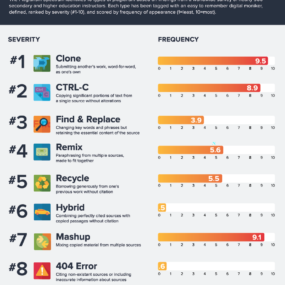All materials
None were found.

10 Types of Plagiarism (handout)
Published: 11.10.2018
The short infographics Plagiarism Spectrum: 10 Types of Plagiarism identifies and describes ten different types of plagiarism. It is available for download in print quality (can be used as a poster, flyer,...). There is also a webinar based on the material. The handout and the webinar ar

Assisting the students to avoid plagiarism
Published: 11.10.2018
Paper about using formative workshops. Abstract This study aims to investigate whether formative lectures alone would (a) enhance the students’ understanding of plagiarism and (b) improve their academic writing or avoid plagiarism. Postgraduate student volunteers were used in this stud

Paraphrase practice 2 (English Language Teaching)
Published: 17.09.2018
The main idea of the exercise is to guide the student step by step from reading a paragraph to writing a paraphrase in own words. Directing questions assist this process. It is based on Paraphrase practice 1 (English Language Teaching) and provides an additional example. The exercise can be used in

Paraphrase practice 3 (English Language Teaching)
Published: 17.09.2018
The main idea of the exercise is to guide the student step by step from reading a paragraph to writing a paraphrase in own words. Directing questions assist this process. It is based on Paraphrase practice 1 (English Language Teaching) and provides additional examples. The exercise can be used in a

Usage of computer software for text matching
Published: 17.09.2018
This material is a translation of an original paper written by Jānis Kreicbergs and published on the web site of University of Latvia. Jānis Kreicbergs is one of the first persons in Latvia who started to develop a national unified computerized plagiarism control system. In this material, he discuss

How to avoid plagiarism: Paraphrasing, quotation and summary
Published: 23.08.2018
Plagiarism means that we take a work or an idea of someone else and present it as our own. To avoid plagiarism the document explains the basic concepts paraphrasing, quotation and summary. Please note that this material is very brief summary. It is not meant as a stand-alone learning material. It ma

How Textual Plagiarism Detection Works
Published: 23.08.2018
This document provides really brief information on the text matching methods. The goal is to get the basic overview.

Paraphrase practice 1 (History)
Published: 20.07.2018
The original exercise is taken form Salim Razi’s book “Advanced Reading and Writing Skills in ELT” (Razi, S. (2011). Advanced Reading and Writing Skills in ELT. APA Style Handbook, Ankara: Nobel, p. 181-183.) and it was designed for students in an English Language Teaching programm

Paraphrase practice 1 (English Language Teaching)
Published: 20.07.2018
The main idea of the exercise is to guide the student step by step from reading a paragraph to writing a paraphrase in own words. Directing questions assist this process. The exercise can be used in any context of teaching students to work with secondary literature and work with it properly. Poor a

The 20 most frequent intertextual errors in student papers at Freiburg University of Education
Published: 13.07.2018
A total of 82 term papers and final theses at Freiburg University of Education, Freiburg, Germany, were examined 2014 – 2016 in terms of their intertextual quality. Of the 109 distinctions made between different types of intertextual errors that are known to us, 58 were detected in the student